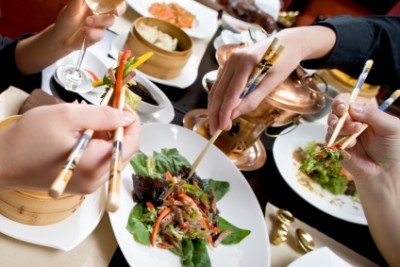Chinese Food for Kids
Types of Chinese Food
In a country as immense as China, the diversity of its food is vast, but there are five major styles which can be attributed to the different regions from which they come from:
| Traditional Chinese Food Types |
Beijing Cuisine in the North: Beijing cuisine is the style prevalent in Northern China. It emphasizes light and subtle flavors and the best ingredients. This style originates in the Imperial court, so the food must be "fit for an emperor". The most famous dish is of course Peking duck and is a must on your trip to Beijing. Wheat is widely grown here in the north, so noodles made from wheat flour replace the rice. Steamed dumplings are also common. |
Sichuan Food in the West: Hot and Spicy characterizes Sichuan food. Chili paste or dried chilies, garlic and ginger are some of the most common ingredients. Some of our favorite Sichuan dishes are Ma Po Tofu and Kong Pao Chicken. Chengdu will be a great place to try out some of these dishes. Also well known in Sichuan is the Hot Pot. In Chongqing, hot pot is considered a local specialty. |
Hunan Food in Central China: Hunan cooking is known for its spicy zest and also sweet and sour flavors. Fresh chilies, garlic and shallots are the staples in the Hunan kitchen. Hunan cuisine relies mainly on frying, stewing and pot roasting as cooking methods. The food also tends to be more on the oily side. The Hunan Sweet and Sour Chicken or Pork are our favorites. |
Cantonese Food in the South: Cantonese is the style best known abroad as it was from this region that most immigrants to America, Europe and Southeast Asia came from, bringing with them their cooking style. Soy and ginger are the main seasonings, and their cooking relies on a great variety of fresh ingredients for flavor. Cantonese food specializes in stir frying, steaming and roasting. This is the style we grew up with at home. Some of our favorite Cantonese dishes: char siu (bar-b-que pork), stir-fried beef and peppers with black bean sauce, lemon chicken and Dim Sum of course! Some well-known Cantonese Delicacies: Shark’s fin soup, Bird’s nest soup. |
The above five styles are considered the "classical" Chinese Cooking styles. Even though the above characteristics are considered typical to each type, the mixing of different regional and traditional styles, cooking methods and ingredients is so widespread, it is difficult to pin point what is "Authentic Beijing Style" or "Authentic Sichuan Cuisine" as nowadays, they all "borrow" from each other. Sweet and sour dishes for example are quite common in Cantonese cooking.
In addition, there are hundreds of local specialties and sub-styles. For example you have probably heard about Shanghai Cuisine. "Shanghai cuisine" is not a separate style of Chinese cooking per se, and it mostly reflects a combination of different styles and influences, mirroring Shanghai’s status as a cosmopolitan and commercial center.
And from all these wonderful cooking styles, each household has its very own Chinese home cooking style. Some of the dishes in the above classical styles can be very elaborate or require a lot of preparation, specially in Beijing and Fujian cooking. Chinese home cooking is in contrast, very simple and quick. We will be sharing with you some popular recipes which are simple enough to make with the kids in any western kitchen.
How a Chinese Meal is served
A typical Chinese meal is normally composed of several “main dishes” as opposed to one main dish. Normally, all dishes are set on the table at once and everybody helps him/herself to the selection. There is typically a couple meat dishes, chicken, beef or pork, a vegetable, fish or seafood, and a soup.
White rice is always at the core of the meal, and is the base for all the individual dishes being served.
Desserts are not common, a meal normally finishes with fresh fruit and in some special occasions with some other sweet like almond custard. Fortune Cookies are not really Chinese, they are an American invention, and you will not find them in China.
Cold drinks like sodas or juices are not served with a typical Chinese meal, although the practice is catching on specially in touristy areas and the bigger cities. Instead, Chinese enjoy a cup of tea or a variety of soups with their meals.
 | A balanced Chinese meal involves two elements:
|
A typical place setting includes:
|  |
NTD's Chinese International Culinary Competition Backstage, Iron Wok "Behind the Chinese 9"

Chinese Culinary Culture by Du Fuxiang,Li Xiaoqing(Paperback),English,2010

- Chinese Culinary Culture
- English
- First Edition
- Paperback
- gelatine plate paper
List Price: $ 29.00 Price: $ 29.00

Comments